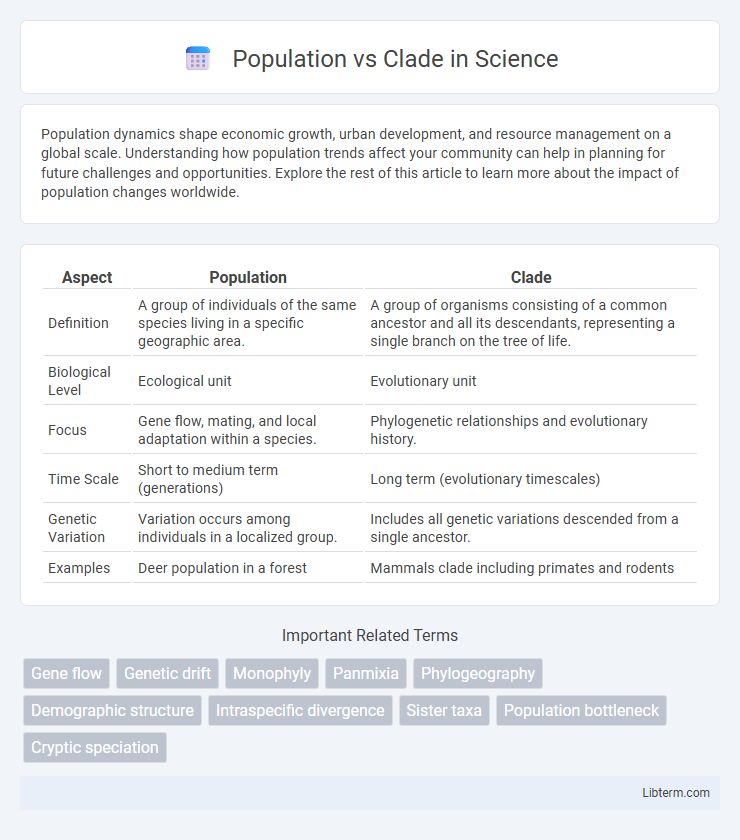Population dynamics shape economic growth, urban development, and resource management on a global scale. Understanding how population trends affect your community can help in planning for future challenges and opportunities. Explore the rest of this article to learn more about the impact of population changes worldwide.
Table of Comparison
| Aspect | Population | Clade |
|---|---|---|
| Definition | A group of individuals of the same species living in a specific geographic area. | A group of organisms consisting of a common ancestor and all its descendants, representing a single branch on the tree of life. |
| Biological Level | Ecological unit | Evolutionary unit |
| Focus | Gene flow, mating, and local adaptation within a species. | Phylogenetic relationships and evolutionary history. |
| Time Scale | Short to medium term (generations) | Long term (evolutionary timescales) |
| Genetic Variation | Variation occurs among individuals in a localized group. | Includes all genetic variations descended from a single ancestor. |
| Examples | Deer population in a forest | Mammals clade including primates and rodents |
Defining Population and Clade: Key Concepts
A population refers to a group of interbreeding organisms of the same species living in a specific geographic area, sharing a common gene pool. A clade represents a monophyletic group of organisms that includes an ancestor and all its descendants, identified by shared derived traits through phylogenetic analysis. Understanding the distinction between population genetics and clade analysis is crucial for studying evolutionary relationships and biodiversity patterns.
Historical Perspectives on Biological Groupings
Historical perspectives on biological groupings reveal that populations were initially understood as localized groups of interbreeding individuals, while clades emerged from cladistics as evolutionary branches defined by common ancestry. Early taxonomy focused on observable traits to classify populations, but the development of phylogenetic systematics shifted emphasis towards clades, which represent monophyletic groups grounded in shared derived characteristics. Advances in molecular biology and genetics have enabled scientists to distinguish clades with greater precision, reshaping traditional population concepts within evolutionary biology.
Genetic Diversity: Population vs Clade
Population genetic diversity reflects variations within a local group of interbreeding organisms, influenced by migration, mutation rates, and selective pressures. Clade genetic diversity encompasses broader evolutionary lineages, representing shared common ancestry and divergence over extended timescales. Comparisons reveal populations capture microevolutionary processes, while clades illustrate macroevolutionary patterns shaping overall biodiversity.
Evolutionary Processes in Populations and Clades
Population-level evolutionary processes involve gene flow, genetic drift, mutation, and natural selection acting on individuals within a local group, leading to changes in allele frequencies over time. Clade evolution encompasses broader speciation events and divergence patterns that reflect shared common ancestry and long-term macroevolutionary dynamics. Understanding the interaction between microevolutionary processes in populations and macroevolutionary trends in clades is essential for interpreting biodiversity and phylogenetic relationships.
Types of Populations and Their Characteristics
Populations are groups of interbreeding individuals of the same species, characterized by types such as local populations, metapopulations, and demographic populations, each with distinct gene flow, size, and spatial distribution. Clades represent evolutionary branches consisting of an ancestor and all its descendants, focusing on phylogenetic relationships rather than population dynamics. Understanding types of populations and their characteristics, like genetic variation and adaptation capacity, is crucial for conservation biology and evolutionary studies.
Clade Analysis: Phylogenetic Relationships
Clade analysis focuses on identifying monophyletic groups within populations by examining shared derived characteristics through phylogenetic relationships. This method uses genetic markers and molecular data to construct evolutionary trees that reveal common ancestry and divergence patterns among species or populations. Understanding clade structures enables a detailed assessment of evolutionary history beyond population-level variation, highlighting lineage-specific adaptations and speciation events.
Methods for Identifying Populations and Clades
Methods for identifying populations typically involve analyzing genetic markers such as microsatellites, single nucleotide polymorphisms (SNPs), and mitochondrial DNA sequences to assess gene flow, genetic diversity, and population structure. Clade identification relies heavily on phylogenetic analyses using molecular data like DNA or RNA sequences to reconstruct evolutionary relationships and detect monophyletic groups reflecting common ancestry. Techniques such as Bayesian inference, maximum likelihood, and neighbor-joining trees are standard approaches in distinguishing clades and understanding evolutionary lineage divergence.
Population Dynamics versus Clade Evolution
Population dynamics investigates changes in population size, density, and structure driven by birth rates, death rates, immigration, and emigration. Clade evolution examines the phylogenetic relationships and ancestral lineage diversification of groups of organisms sharing common traits. Understanding population dynamics aids in modeling short-term species survival, while clade evolution reveals long-term evolutionary patterns and speciation events through genetic divergence.
Implications for Conservation Biology
Population and clade distinctions critically influence conservation strategies by determining evolutionary significant units and genetic diversity preservation. Populations represent localized gene pools, essential for adaptive potential and demographic resilience, while clades encompass broader evolutionary lineages reflecting deep phylogenetic relationships. Prioritizing conservation based on clade diversity helps maintain long-term evolutionary processes, whereas managing populations ensures immediate survival and genetic health of species.
Conclusion: Integrating Population and Clade Perspectives
Integrating population and clade perspectives enhances understanding of evolutionary dynamics by combining genetic diversity within populations with broader phylogenetic relationships across clades. This approach allows researchers to accurately trace lineage-specific adaptations and demographic histories, providing a comprehensive framework for studying biodiversity patterns. Emphasizing both microevolutionary processes in populations and macroevolutionary trends in clades aligns insights across evolutionary scales for improved conservation and biological analysis.
Population Infographic

 libterm.com
libterm.com